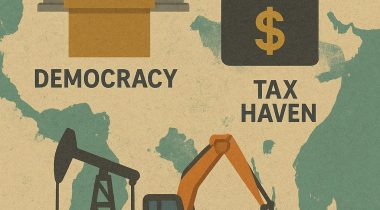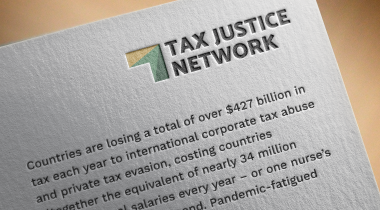
Mark Bou Mansour ■ How City of London finance is making us poorer – infographic

A new report published today by the Sheffield Political Economy Research Institute at the University of Sheffield reveals the UK’s oversized financial sector has cost the economy £4.5 trillion in lost economic output between 1995 and 2015 – equivalent to £67,500 for every person in the UK.
The report finds that the UK economy would likely have performed much better in overall growth terms if its finance sector was smaller, and if finance was more focused on supporting other productive areas of the economy.
Also published today is a new book by Nicholas Shaxson, entitled The Finance Curse: How Global Finance is Making Us All Poorer. The book sets out a new economic framework referred to as the “finance curse” for understanding how a financial centre that has grown above its useful size and role becomes predatory and harmful to the economy that hosts it. He argues the City of London is draining resources and talent from other economic sectors, creating large economic inequalities and spurring financial crises.
Scroll down to view infographics and videos about the finance curse and how it impacts on us all. You can read Nicholas Shaxson’s Guardian long read here, his blog here and our full press release here.

Video: The Finance Curse
Video: What is Financialisation?
Video: The ‘Competition Agenda’ – why market competition between nations is a bad idea:
Related articles

‘Illicit financial flows as a definition is the elephant in the room’ — India at the UN tax negotiations

Democracy, Natural Resources, and the use of Tax Havens by Firms in Emerging Markets

The Financial Secrecy Index, a cherished tool for policy research across the globe

Do it like a tax haven: deny 24,000 children an education to send 2 to school

Tax Justice transformational moments of 2024
The State of Tax Justice 2024

Indicator deep dive: ‘Royalties’ and ‘Services’

Indicator deep dive: Public country by country reporting
Profit shifting by multinational corporations: Evidence from transaction-level data in Nigeria
5 June 2024



Thank you very much, I did not know of the Sheffield study.
Please, would it be possible to get a copy of the splendid “infographic” separately ? That could be very helpful
Best wishes, adj
Thanks for getting in touch!
A copy of the infographic will be sent to you by email.
The sheffield link is broken
THE MOST SOCIALLY JUST TAX (AND ITS 17 EFFECTS ON THE NATIONAL ECONOMY)
A wise and sensible government would recognize that this problem derives from lack of opportunity to work and earn. It can be solved by the use of a tax-system which encourages the proper use of land and which stops penalizing everything and everybody else except for the greedy few whose site ownership is such a limitation on good prospects. Such a tax-system was proposed 139 years ago by Henry George, a US American economist. Somehow most macro-economists seem never to have heard of him, in common with a whole lot of other experts who work with land. (I would guess that they don’t want to know, which is worse!) In “Progress and Poverty”, of 1879”, reprinted by Schalkenbach Foundation, NY, 1978, Henry George proposed a SingleTax on land-values without there being other kinds of tax on produce, services, capital-gains, etc. The value of a site is related to the economic rent that it generates, when it is properly used. It was this rent that George actually wanted to collect, as if it were a tax (although the terminology of LVT is not strictly correct, because it is not a tax but a revenue and one that is directly connected to the ideal or economic rent, and not the land-value itself.)
This regime of the so called land-value tax (LVT) has 17 features which benefit almost everyone in the economy, except for landlords and banks, who/which do nothing productive and find that land dominance has its own reward. Such a taxation regime collects the economic rent from the land owners of the particular sites. This mostly stable rent depends on the potential productive capacity of the site, whilst its (capitalized) land value varies and depends on the comparable rates of interest and dividends that can be generated by other competing kinds of investments in durable capital goods.
17 Effects of LVT on Government, Land Owners, Communities and Ethics:
Four Aspects for Better Government:
1. LVT, adds to the national income as do other taxation systems, but it should be introduced to replace them.
2. The cost of collecting the LVT will be less than for all of the other taxed production-related items. This is because with LVT its avoidance becomes impossible–the sites are visible to all and their ownership is public knowledge.
3. Consumers will pay less for their purchases due to lower production costs (see below). This creates greater satisfaction with the government whose management is of the national affairs.
4. The national economy stabilizes—it no longer experiences the 18 year business boom/bust cycle, due to periodic speculation in land-values (see below). The speculation in and withholding of unused land is eliminated, see item 7.
Six Aspects Affecting Land Owners:
5. LVT is progressive–owners of the most potentially productive sites will pay the most tax. Urban sites that have the most usefulness–consequently the taxation of their values provides most of the resulting national income. Big rural sites have less value and can be farmed in the appropriate manner, according to their ability to efficiently provide useful consumer produce. Small scale farming is less costly due to more convenient and affordable locations regarding marketing and produce distribution.
6. The land owner pays his potential LVT regardless of how his site is used. A large proportion of the present-day ground-rent from the tenants becomes the LVT, with the result that land has less sales-value but retains a significant rental-value (even when it is not being used).
7. Consequently LVT stops speculation in land prices, because the withholding of land from proper use is no longer worthwhile.
8. The introduction of LVT initially reduces the sales price of sites, even though their rental value can still grow over a longer term. As more sites become available, the competition for them becomes less fierce.
9. With LVT, land owners are unable to pass the tax on to their tenants as rent hikes, due to the reduced competition for access to the additional sites that come into use.
10. With LVT, land prices will initially drop. Speculators in land-values will want to foreclose on their mortgages and withdraw their money for reinvestment. Therefore LVT should be introduced gradually, to allow these speculators sufficient time to transfer their money to company-shares etc., and simultaneously this investment will meet the increased demand for produce (see below, items 12 and 13).
Three Aspects Regarding Improved Communities:
11. With LVT, there is a proper incentive to use land for production or residence, rather than it being unused.
12. With LVT, greater working opportunities exist due to cheaper land and a greater number of available sites. Consumer goods become less costly too, because entrepreneurs have less difficulty in starting-up their businesses and because they need to pay less ground-rent. So demand grows, and can be better met by supply, whilst unemployment decreases.
13. Investment money is withdrawn from land and placed in durable capital goods. This also means more advances in technology and cheaper produce of goods.
Four Aspects About Ethics:
14. The collection of taxes from our productive efforts and commerce is socially unjust. LVT replaces this national extortion by gathering the surplus rental income instead. It is surplus because it comes without any exertion from the land-owner or by the banks– LVT is a natural system of national income-gathering.
15. The previous bribery and corruption will cease. It is no longer any advantage for gaining privileged information about planned developments in land. Before, this was due to the leaking of news of municipal plans for housing and industrial growth, causing shock-waves in local land prices (and municipal workers’ and lawyers’ bank-balances).
16. The improved use of the more central land of cities reduces the environmental damage due to: a) unused sites being temporary dumping-grounds, and b) the smaller amount of air-polluting fossil-fuel use, when traveling between home and workplace and when distributing produce to sales places.
17. Because the LVT eliminates the advantage that landlords currently hold over our society, LVT provides a greater equality of opportunity to earn a living. Entrepreneurs can operate in a natural way– to provide more jobs because their production costs are reduced. Then untaxed earnings will correspond more closely to the value that the labor puts into the product or service.
Consequently, after LVT has been properly and fully introduced as a Single Tax, it will eliminate poverty, improve business ethics and result in a fairer sharing of the resulting prosperity due to proper land use.
It’s not just the finance sector that’s the problem, it’s the whole FIRE (finance, insurance, real estate) sector which screws us. I’ve long been concerned about the funding of private pensions which wastes so many resources, including good quality labour. I understand that the whole ‘industry’ only exists because of tax reliefs. I was persuaded some time ago of the logic that pensions are deferred wages and so it is correct to fund the state pension from NICS (both employers’ and employees’). However, since coming to understand MMT I now believe that they should not be ‘funded’ at all but just ‘magicked’ from the tree. Private saving for retirement needs no subsidy (in fact savers should only expect to retain their purchasing power for future spending – asset purchases contribute nothing to capital formation after all). Am I wrong?
May I also have a copy of the infographic via e-mail! I tried to print it myself but could not do so.
Hi, the infographic is displaying at such low resolution that it’s impossible to read any of the information contained in it. Would it be possible to upload a higher resolution? Or a vector image format (eg PNG instead of JPG) so that it can automatically resize itself without losing any resolution?
Many Thanks!
Thank you for the heads up about the infographic, Sheila. We updated our website recently but the infographic was not properly reformatted to appear clearly on the new website layout. I’ve now resized the infographic to a higher resolution to look clear now. Thanks again.